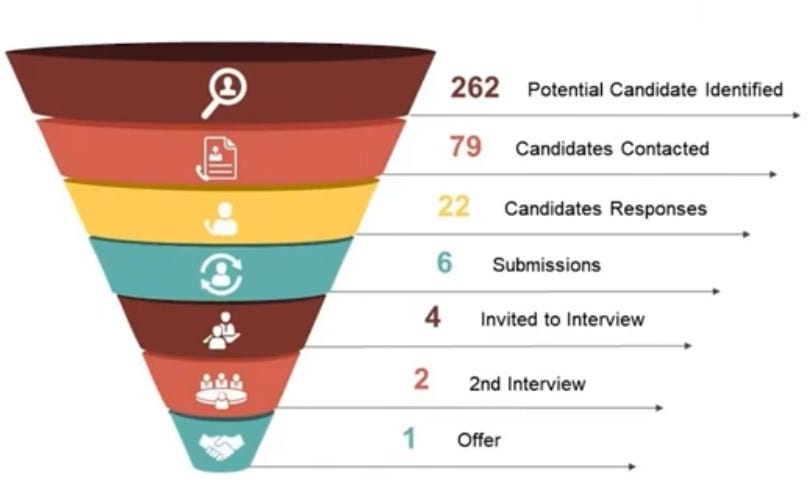Getting an offer means getting interviews.
Recruiters know that many students have little to no work experience. And the majority of them look at extracurricular activities and involvement when they screen resumes. That's why prior internships or side-projects help your chances.
It may seem as if recruiters have a lot of power, but they don't. They're just following a simple funnel to get the best talent. Your job is to get down each part of the funnel until you get an offer.
Most students only aim for the top of the recruiting funnel. They never even consider the different moving parts right below it. What happens when the recruiter contacts you for an interview and you're not prepared for it? What if you miraculously pass the interview, and find out there's a second and third-round?
This is why you should aim for the interview, not the job.
Don't mass apply to a bunch of jobs
Recruiting is a lot like hitting a bullseye. The bullseye is your list of target companies and the darts are interviews. If you know where your bullseye is, then it's just a matter of practicing and throwing enough darts.
Most people do the complete opposite. They turn their back to the bullseye and shoot their darts aimlessly at mindless objects.
In more practical terms, people follow the old adage that you should apply to as many companies as possible because your odds will increase, and eventually you will land a role. While this approach may have worked in the 2000s and even early 2010s (hence the people giving this outdated advice), it's flawed in today's digital age. Times have changed.
When you spend time applying to hundreds of companies, you take away meaningful time from practicing your interview skills and developing quality relationships. This is way more efficient than applying to every Indeed/LinkedIn job posting.
Here's an example
Let's say I am aiming for a product management internship at a big tech company. My first step is to find all the tech companies I'm interested in. Then, track down when and where they do virtual/campus events. Recruiters use websites like Jumpstart, LinkedIn Events, and HireVue (yes, recruiters use this to find candidates) for events.
I want to let the recruiter know that I'm interested in their company and want to interview. In addition, I'll go through my LinkedIn network to see if there's anyone working at those companies or in the worst-case scenario, any 2nd-degree connections who know people there that can give me a referral to a first-round interview or recruiter screening call.
This takes effort, but it'll be well worth it when you move down the recruiting funnel and land an interview. I'd much rather do this with 8-12 targeted companies than apply to 200 and expect something to happen. At the same time, I'll be practicing for my interview by having mock interviews through websites like Pramp and researching effective interview answers through iGotAnOffer, TryExponent, and Glassdoor.
Notice that this process is not about landing the job but rather the interview. In his famous TED Talk, Stephen Duneier says the best way to accomplish your most ambitious goals is to break them down into smaller pieces. In a similar way, recruiting is a set of interviews—which in turn are behavioral and technical questions. If you nail enough interviews, you'll get the offer.
The Takeaway
When athletes get interviewed, they always say they're taking everything one game at a time in route to a championship. In a similar way, your goal is to tackle one interview at a time in route to an offer.
Resources of the Week
Internships of the Week
Mailchimp - Summer Product Marketing Intern (Atlanta)
Laconia - VC Intern (Remote)
Blend - Summer Brand Design Intern (SF)
Datadog - Winter, Summer Product Manager Interns (NYC)








